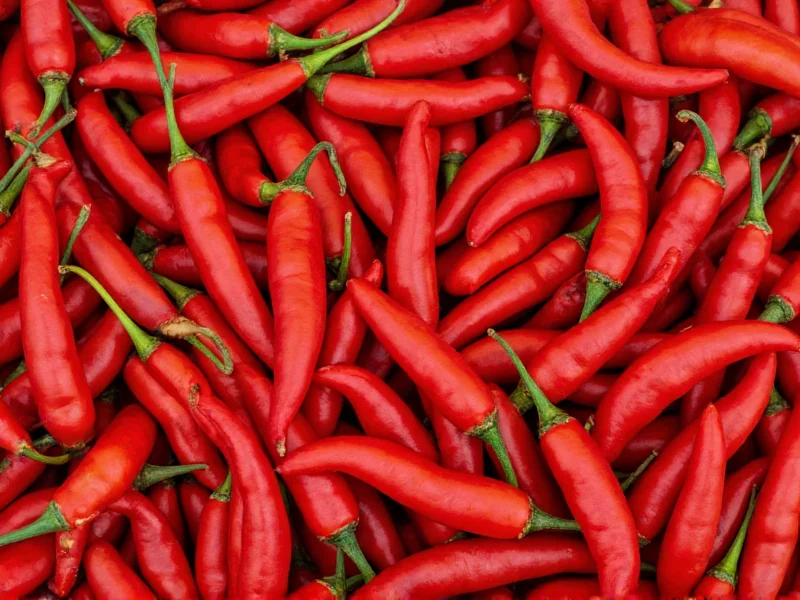When exploring the world of chili peppers, one common question arises: are red chillies hot? The straightforward answer is yes—most red chillies contain capsaicin, the chemical compound that creates that characteristic burning sensation. However, the degree of heat varies significantly across different varieties and depends on multiple factors including ripeness, growing conditions, and genetic makeup.
The Science Behind Chili Heat
Capsaicinoids, particularly capsaicin, are the active components in chili peppers that stimulate thermoreceptor neurons in your mouth and skin, creating the sensation of heat. These compounds concentrate primarily in the placenta (the white ribs inside the pepper) and to a lesser extent in the flesh. As chili peppers mature from green to red, their capsaicin content typically increases, explaining why red varieties often pack more heat than their younger green versions.
The Scoville scale measures chili pepper heat by determining how much sugar-water is needed to dilute the capsaicin until it's no longer detectable. This measurement system, developed by pharmacist Wilbur Scoville in 1912, remains the standard for quantifying pepper spiciness today.
Red Chilli Varieties and Their Heat Levels
Not all red chillies deliver the same level of heat. Some popular red varieties and their typical Scoville Heat Units (SHU) include:
| Red Chilli Variety | Scoville Heat Units (SHU) | Heat Level Description |
|---|---|---|
| Cayenne Pepper | 30,000-50,000 | Moderately hot with sharp, immediate burn |
| Red Jalapeño | 2,500-8,000 | Mild to medium heat, often used fresh |
| Red Serrano | 10,000-23,000 | Noticeably hotter than jalapeños |
| Red Habanero | 100,000-350,000 | Extremely hot with fruity undertones |
| Red Ghost Pepper (Bhut Jolokia) | 800,000-1,041,427 | Exceptionally hot, requires careful handling |
Why Color Change Affects Heat
The transformation from green to red represents the ripening process of chili peppers. As peppers mature:
- Chlorophyll breaks down, revealing red carotenoid pigments
- Capsaicin production often increases during ripening
- Sugar content rises, creating more complex flavor profiles
- Cell structure changes, affecting texture and heat distribution
This explains why are red chillies hotter than green is a common question—in many varieties, the answer is yes. For example, a green jalapeño typically measures 2,500-5,000 SHU, while its red counterpart reaches 5,000-8,000 SHU. However, this isn't universal across all pepper types, as some varieties maintain similar heat levels regardless of color.
Factors Influencing Red Chilli Heat
Several elements affect how hot your red chillies will be:
- Genetics: Different varieties have predetermined heat potential
- Stress conditions: Drought or nutrient deficiency can increase capsaicin production
- Ripeness: Fully mature red peppers often contain more capsaicin
- Part of the pepper: Seeds and placenta contain the highest concentration
- Preparation method: Cooking can sometimes intensify perceived heat
Understanding these variables helps explain why are all red chillies spicy isn't a simple yes-or-no question. While most red chillies contain some capsaicin, certain sweet pepper varieties like red bell peppers have been bred to contain negligible amounts, registering 0 SHU on the Scoville scale.
Practical Applications in Cooking
Chefs and home cooks can leverage the heat properties of red chillies in various ways:
- Remove seeds and white membranes for milder flavor while retaining color
- Use dried red chillies for concentrated heat in sauces and rubs
- Balance extreme heat with dairy products (casein neutralizes capsaicin)
- Pair specific red chilli varieties with complementary flavors
- Understand that cooking doesn't destroy capsaicin but can distribute it more evenly
When working with extremely hot red chillies like habaneros or ghost peppers, always wear gloves and avoid touching your face. The capsaicin oils can cause significant irritation to sensitive areas, even after washing your hands.
Health Considerations
While red chillies add exciting flavor to dishes, their heat requires mindful consumption. Capsaicin triggers the release of endorphins, creating a pleasurable sensation for many people. However, excessive consumption can cause digestive discomfort, especially for those with sensitive stomachs. The compound also has potential health benefits, including pain relief properties and metabolism boosting effects, though these should not be considered medical advice.











 浙公网安备
33010002000092号
浙公网安备
33010002000092号 浙B2-20120091-4
浙B2-20120091-4